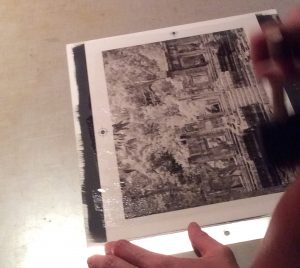Ancient Splendour – World Heritage Sites photographs are presented in two alternative printmaking processes.
Platinum Palladium and Tri-colour Bichromate over Palladium
Photographic printmaking processes that were developed in the 1800’s and used by early photographers.
“We have chosen these two processes as they have the look, texture and feeling of work done in the very beginning of photographic printmaking. These images are of historically significant subjects. Contemporary prints cannot give us the colour palette and physical sense that these two processes offer. In both cases the paper is arches platine, which is produced in France and has been offered for over three hundred years. The noble metal of platinum palladium sinks into the very fabric of this paper and any resulting pigment is layered on top for an exquisite image.” (Bob Carnie)
Platinum Palladium Prints
The Platinum process (platinotype) was popular in the late 1800’s and early 1900’s. Falling out of favour due to skyrocketing cost of Platinum during World War 1, a switch was made to Palladium but by 1930 it’s cost had risen also so the process was mostly abandoned for more economical printing methods. Today the permanence (archival longevity) and aesthetics (rich and warm tonal range, sense of depth with delicate highlights and soft surface quality) of the Platinum Palladium prints is worth achieving despite the cost. Being a contact printing process, a negative the size of the final print is required. Using modern technology we are able to print a digital negative on clear film (such as Pictorico) to size specifications. Working in a dimly lit space rather than a darkroom, high quality cotton watercolour paper is coated with a platinum, palladium and ferric oxalate emulsion. The negative in contact with the coated paper is exposed to ultraviolet light, then the print is developed, rinsed, cleared, washed and dried.
Tri Colour Bichromate Gum Prints
These are contact prints that require a full size negative for each layer. Using current technology, PhotoShop is used to separate the image into five layers from which digital negatives can be printed. One is to use as a positive for future negative registration, another to produce a black and white palladium image on the arches platine and the other three layers are Yellow, Magenta and Cyan negatives which are the subtractive colours that when combined on top of the platinum palladium creates a full tone rendition of the original scene. To produce a single print is very labour intensive. Each layer is individually coated, registered, exposed, developed, washed and dried before applying the next layer. Each step takes hours, so every single image could take days to produce. Due to the nature of the process each print is unique and cannot be exactly replicated. The resulting prints look more like watercolour paintings than modern photographs.








